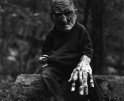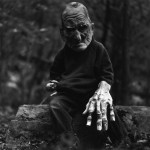The Dynamics of Photography and Disability: Jen White-Johnson

Installation photo Autistic Joy, 2023, Photoville Festival, NY, Photo by Jen White-Johnson Image: A photo collage on the wall of a container. The collage is photos of Jen’s son Knox, a Black Autistic child. Images show Knox painting with light, outdoors smiling at the camera, and wrapped up in a blue blanket. The images are of Knox at different ages
This week we are looking at projects by disabled/chronically ill photographers. The definition of dynamics is “forces or properties which stimulate growth, development, or change within a system or process.” Each of these artists is approaching their work in ways that embrace this meaning, enacting change and raising important questions about societal systems through their ideas, craft, and processes they use.
Jen White-Johnson is a disabled and Neurodivergent Afro-Latina art activist and design educator whose visual work aims to uplift disability justice narratives in design. As an artist-educator with Graves disease and ADHD, Jen uses photography, zines and collage art to explore the intersection of content and caregiving, emphasizing redesigning ableist visual culture. Jen has presented her disability justice activist work and collaborated with a number of brands and art spaces across print and digital such as Adobe, Target, and Coachella. Her design work and writings have been featured in The Washington Post, AfroPunk, Art in America, and is permanently archived in libraries at The Metropolitan Museum of Art, National museum of women in the arts and her work was recently acquired by the Smithsonian National Museum of African American History and Culture. Jen has an MFA in Graphic Design from The Maryland Institute College of Art, where she currently teaches design. Jen lives in Baltimore with her husband Kevin and 11-year-old son Knox.
You can follow Jen’s journey and work on Instagram at @jtknoxroxs and at jenwhitejohnson.com

Artists Portrait Jen White-Johnson, Juxtapoz Magazine, 2023, Photo by Chris Metzger and Jalen Thomas. Image: Jen an Afro-Latin woman with shoulder-length light brown hair is wearing a tan wide-brimmed hat and black t-shirt with Bell Hooks’ name and an image with lightning bolts. Behind Jen are wheat-pasted posters of her graphic design, most prominent a black fist with white text “Black Disabled Lives Matter” with an infinity symbol on the wrist.
MB: To start would you please tell us a little bit about yourself?
JWJ: I’m a disabled and neurodivergent Afro-Latina art activist and design educator. My visual work aims to uplift disability justice narratives in design and explore the intersection of content and caregiving with an emphasis on redesigning ableist visual culture.

Artist Mother Studio Portrait of Knox, 2020, Photo by Jen White-Johnson Image: Knox stands in Jen’s studio, He is looking at an iPad and wearing headphones, a bright red vest, a striped shirt, and jeans. Over his shoulder is a large canvas bag with black text, “Mama raised a revolution.”
MB: What does disability mean to you personally and in your art practice?
JWJ: It means Mothering is an Act of Resistance. My Revolutionary mothering art & design practice is rooted in Black Feminist Disability Framework, Basically creating the work I don’t see amplified as much in mainstream media.
Having a Neurodivergent kid showed and encouraged me to hold space for my own ADHD and consider getting officially diagnosed. I also I began to think about Design and how it overlaps with my own Neurodiversity.

Installation photo Autistic Joy, 2023, Photoville Festival, NY, Photo by Jen White-Johnson Image: A photo collage encompassing all the walls of a container. The collages are photos of Jen’s son Knox, a Black Autistic child. Photos show Knox smiling at the camera, painting with light, silhouetted outlines of Jen and Knox with the sky behind them. Someone is standing in the container experiencing the exhibition.
MB: Over the summer you and your son Knox had a collaborative exhibition, Autistic Joy, with Photoville celebrating and creating space for Black and Brown disabled and neurodivergent folks. What was your experience at the Photoville Festival? What response did you and Knox receive to the exhibition?
JWJ: Photoville was an absolute triumph! Our space resonated deeply with attendees, who enthusiastically embraced and applauded the celebration within. Our overarching mission, to amplify joy and justice through visual representation, reverberated powerfully throughout the event. Knox, our inspiring advocate, seized the opportunity to forge meaningful connections and engage in captivating conversations with visitors. Witnessing his comfort and passion while discussing the profound joy encapsulated in his favorite photos was nothing short of extraordinary—a true testament to our commitment to shatter stereotypes.
Our photo container became a global hub, drawing individuals from all corners of the world who were captivated by the chance to converse with Knox in person and experience his Autistic Joy firsthand. Breaking barriers and dispelling misconceptions, we transformed Photoville into a vibrant nexus of shared experiences and understanding.
Education outreach initiatives took center stage as we relentlessly pursued our goal to foster awareness and understanding. I was honored to lead an Autistic Joy zine-making workshop within the Photoville community, where participants contributed their unique Autistic journeys.
The collective energy and enthusiasm were palpable, cementing our commitment to inspire, educate, and break down barriers. Photoville not only showcased visual brilliance but also emerged as a dynamic force for positive change. Together, we’re rewriting narratives and creating a more inclusive world—one joyous and just image at a time. Here’s to breaking stigmas, fostering connections, and continuing the journey toward a more enlightened future!
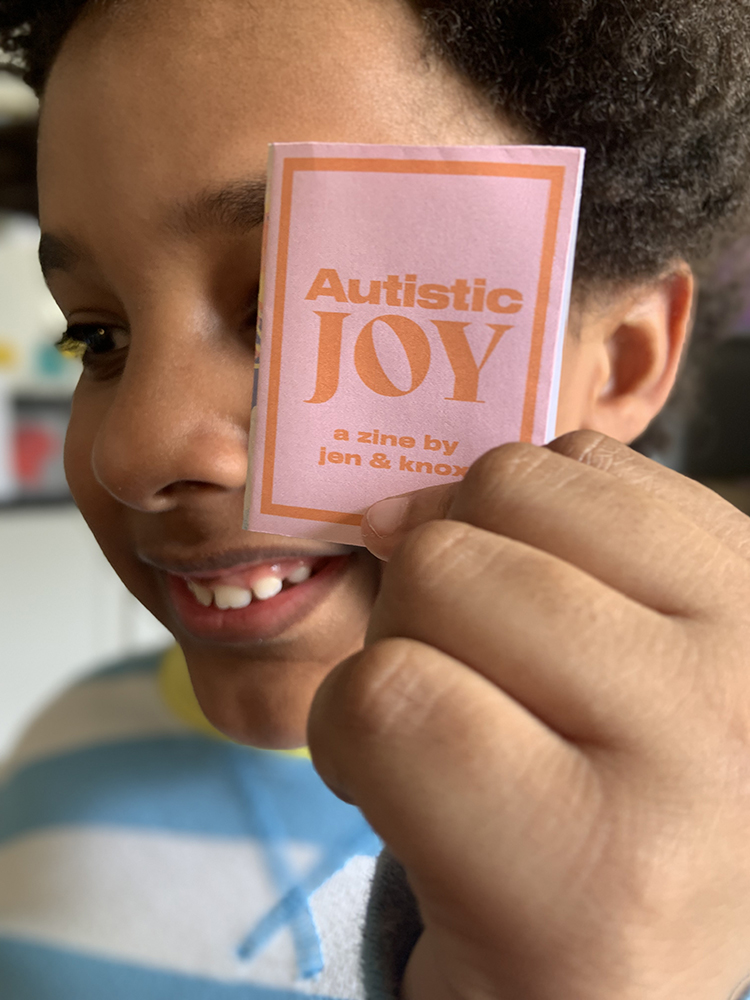
Kids Solidarity Mini Zine Pack 2021, photo by Jen White-Johnson Image: Knox holds a mini zine up by his face, the zine covering one eye. Knox is smiling. The zine is light pink with orange text, “Autistic Joy, a zine by Jen & Knox.”
MB: I would love to learn more about your collaborative process with Knox.
JWJ: In the vibrant spring of 2020, amidst the isolating haze of the pandemic, we ignited a spark of connection with our very first Kids Solidarity Virtual Zine Fest. Fueled by a desire to forge social bonds, we delved into the world of zine-making—a delightful fusion of sensory exploration and expressive storytelling that kept our Neurodivergent minds ablaze with creativity and a love for words! Empowering my Autistic son to embrace experimental art has been a revelation, a catalyst propelling my own journey of creative ADHD self-discovery and design innovation.
We were able to joyfully extend an invitation to the zine community to revel in the fruits of our creative collaboration. Enclosed within this vibrant pack are mini zines that encapsulate Knox’s boundless affection for the cosmos, the rhythmic tapestry of music, and the pure elation of joy. Each creation is a kaleidoscope of our shared passions and sentiments, a testament to the profound impact of embracing expressive exploration. As you leaf through these pages, you’re not just reading; you’re immersing yourself in a celebration of Radical Joy and Black Autistic Joy. Our belief is simple but profound: joy is beautiful, luminous, and expressive—it is the very essence of Radical Joy. We asked folks to Join us on this spirited journey, as they engage with each page, remember the liberating mantra—believe in the freedom of being you!

Kids Solidarity Mini Zine Pack 2021, photo by Jen White-Johnson Image: A light red cutting mat with a grid of an inch and a half-inch markers. On top of the mat lay 5 zines, all with a black and white close-up photo of Knox’s eye and half his face. White text is overlaid on the photo, “This is ME.”
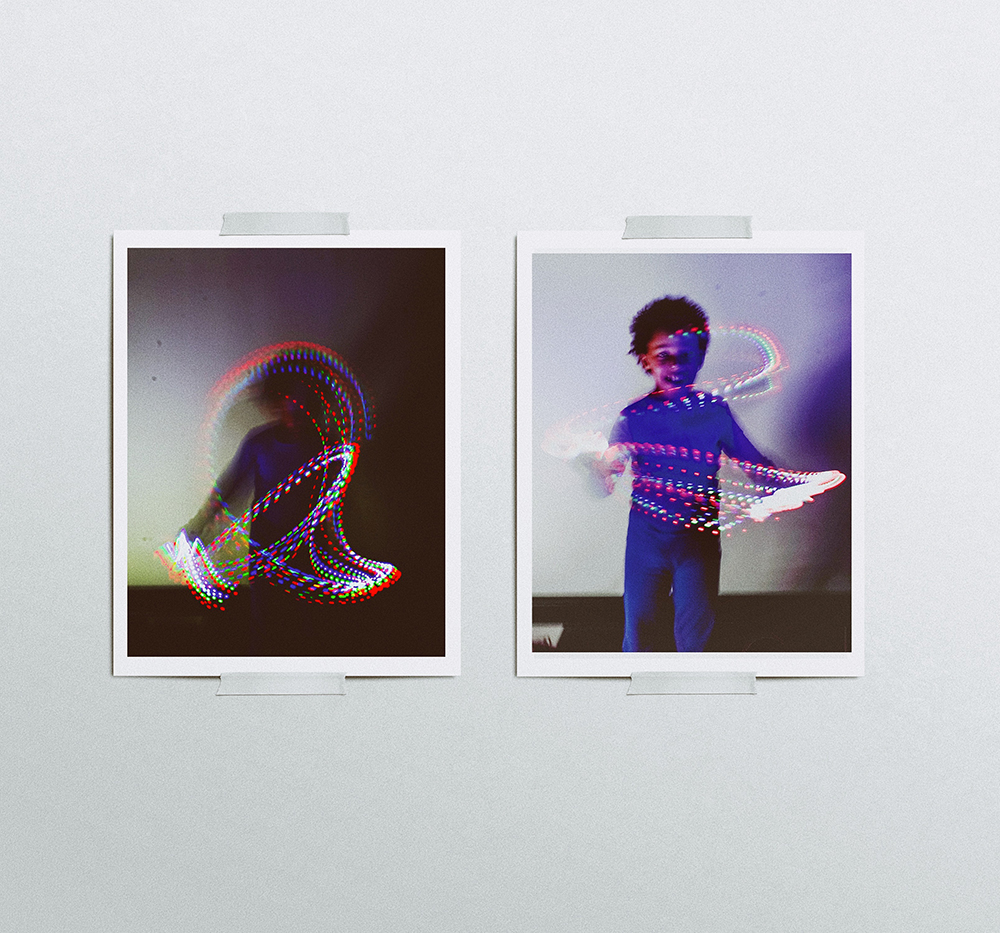
Autistic Joy Photo Series, 2020, Photo By Jen White-Johnson Image: Two photos are taped to a wall. In both images Knox is dancing with light, in the image on the left the lights are more vibrant and his body is in silhouette. On The right Knox is visible and the light patterns weave in and out in front of him.
MB: Was this your first photo exhibition together?
JWJ: Technically yes, but Ah, the tale of first photo exhibition—the one that almost was, had it not been for the tumultuous swirl of 2020! In the midst of what could have been a setback, we artists stood resilient, turning sacrifice into a canvas of shared creativity.
Picture this: I was nestled in the embrace of an incredible Artist Mother Studio Residency when the unforeseen forced us to bid adieu to our cherished studios. But did that dampen our spirits? Not in the slightest! Knox and I transformed our home into a vibrant haven of artistic exploration, a realm where zines and whimsical photo experiments danced with delight.
From the cozy corners of our makeshift studio, we embarked on a journey of collaborative creation. Our light and projection photography—oh, they were our favorites, shimmering with the sheer joy of expression! Every click, every stroke of light, was a celebration of resilience and an ode to the unstoppable spirit of creativity. In the face of adversity, we didn’t merely adapt; we thrived, painting our days with the vivid hues of collaboration and experimentation. What could have been a mere detour turned into a kaleidoscopic adventure, where the constraints of 2020 became the catalyst for joyous, vibrant artistry. Here’s to turning challenges into canvases and creating a masterpiece from the heart of home—our joyful sanctuary of creativity!
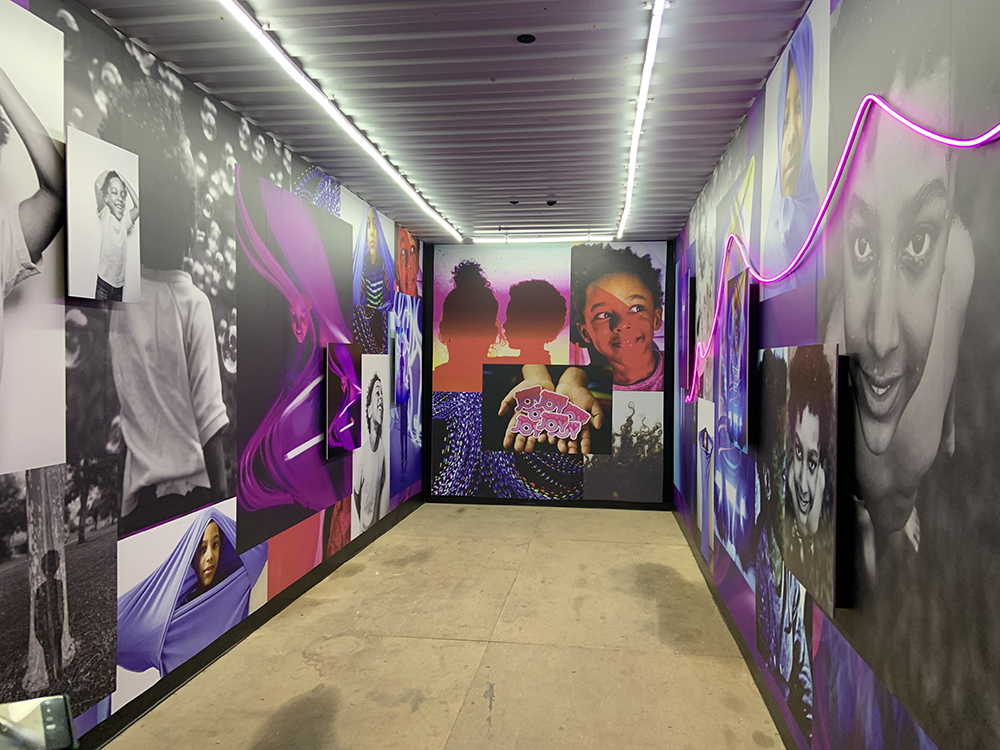
Photoville Autistic Joy Exhibition, 2023, Photo by Jen White-Johnson. Image: A photo collage encompassing all the walls of a container. The collages are photos of Knox and Jen. Photos show Knox smiling at the camera, painting with light, silhouetted outlines of Jen and Knox with the sky behind them, hands holding “Autistic Joy” stickers.
MB: The exhibition focused on joy and you and Knox’s joy was so palpable in the video interview with Photoville. Can you share more about the importance of joy as an act of resistance?
JWJ: In this awakening, I found not just a personal calling but a vibrant purpose. My art and design practice emerged as a dynamic force, a beacon guiding me toward a framework for community engagement that transcended the traditional boundaries of advocacy. No longer content with merely existing, I became a proactive advocate for the beautifully diverse world of autistic communities. Each stroke of my artistic expression, every design nuance, and every creative endeavor became a rallying cry—a galvanizing force that resonates with the heartbeat of neurodivergent experiences. As a disabled parent raising a disabled child, my mission crystallized: to weave a tapestry of vibrant engagement and redefine the narrative surrounding neurodiversity. Together, let us celebrate the kaleidoscope of abilities and perspectives within our community. Through art and design, we don’t just advocate; we elevate. This is not just a journey; it’s a dynamic, ever-evolving dance towards a more inclusive and vibrant world. With each project I ask folks to join me in the symphony of empowerment, where our collective voices echo the undeniable truth—neurodivergence is not a limitation but a canvas for boundless possibilities! A true radical act of resistance!
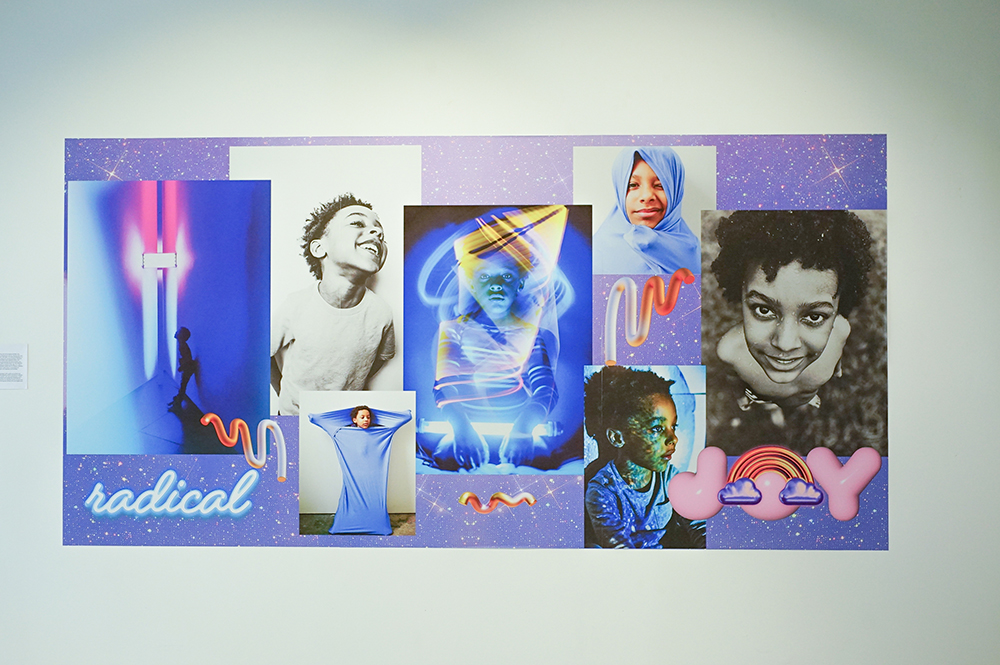
Disrupt and Resist Exhibition, Autistic Joy Photo Mural 2023, Photo by Jen White-Johnson Image: A photo mural on the gallery wall. It has a light purple background filled with sparkling stars. There is a collage of photos of Knox smiling, dancing with light, wrapped in a blue blanket, and in front of a bright pink & blue light sculpture. In the bottom left is “radical” in white cursive. In the bottom right are pink bubble letters “joy” with a rainbow arch over the top of the O.
MB: You recently curated an exhibition Disrupt And Resist: A Love Letter To The Disability Community On What Showing Up For Each Other Can Be, at Mason Exhibitions. Some common threads I find in your work are community, care, and creating spaces to uplift intersectional disabled voices. How did this emerge in your curatorial practice? What were some highlights from this exhibition?
JWJ: Disrupt and Resist was a long time in the making! Embarking on the exhilarating journey of co-curating my first-ever exhibition centering on disability joy and justice was nothing short of a galvanizing odyssey. The response from our vibrant community was phenomenal! The affirmations ushered in so many opportunities for connection.
As the exhibition unfolded, the opening night became a transformative experience, a kaleidoscope of emotions where individuals, long overlooked, finally felt seen and valued. The resonance was palpable—each piece, every narrative, a brushstroke contributing to a larger masterpiece of recognition and celebration.
In the glow of the gallery lights, the atmosphere crackled with the electric energy of validation. The exhibition was not merely an assemblage of artworks; it was a testament to the power of representation and the profound impact of elevating disability joy and justice to center stage.
Amidst the gathered crowd, a vibrant tapestry of shared experiences unfolded—a community finding solidarity, inspiration, and empowerment in what was presented to them. Our collective voices merged into a rallying cry, echoing the undeniable truth that disability joy and justice are not just concepts; they are dynamic forces shaping our shared narrative.
This inaugural foray into co-curating was not just an exhibition; it was a seismic moment—a call to action, a celebration of diversity, and a resounding declaration that, here and now, we are crafting a future where everyone is seen, valued, and celebrated. Collective Liberation in its truest form! The reverberations of this experience are not merely echoes but a resounding chorus, an anthem of access and inclusion that continues to reverberate through our community. I’m excited to share that the show has actually been extended into 2024 and we’re bringing in additional disabled artists!
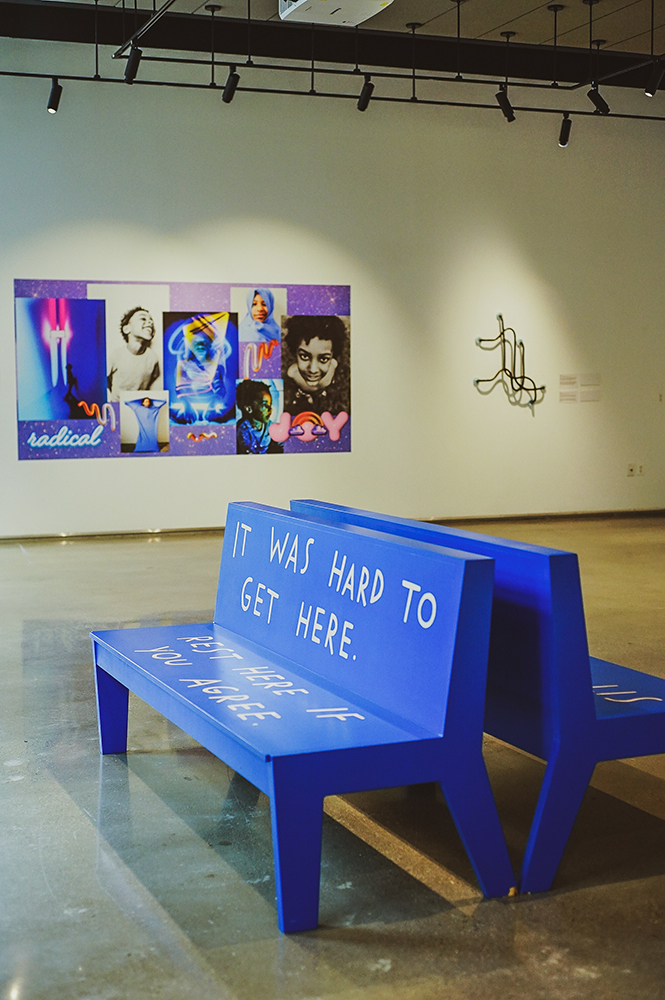
Disrupt and Resist Exhibition, 2023, Photo by Jen White-Johnson Image: In the foreground are two bright blue benches with their backs against each other. White text visible on one bench “It was hard to get here. Rest here if you agree”. Bench by Finnegan Shannon. On the gallery wall in the background is Jen’s photo mural and a sculptural installation on the wall made from grab bars by Alx Velozo

Wassaic Project Artist Residency Soul of Neurodiversity Zine Garden, 2022, photo by Jen White-Johnson Image: A tree with a cord around it. Attached are several mini zines affixed by small clothespins. Zines are yellow, pink, flower-shaped, or have a photo of Knox on the cover. Some zine titles are “Neurodiversity is for everyone.”, “We must not let ableism win.”, Let autistic kids play.”
MB: Another place I recognize your attention to building community is in your Zine workshops. Both in the physical space you create and also through materials – like bringing some of your anti-ableist designs and digital collages for folks to use. I love Zines and I am interested in learning more about how you see their importance as an art form. Can you share more about what the workshop experiences have been like?
JWJ: Zines have evolved into our unique language, serving as a lifeline that enables us to craft spaces steeped in joy. As individuals navigating the realms of disability and neurodivergence, we’ve often found that even well-intentioned spaces can inadvertently perpetuate ableism. Enter zine workshops—an oasis where the cacophony of creativity resembles the improvisational nature of jazz. In these workshops, we don’t just create; we facilitate spaces of solidarity, inviting others to share their narratives through a medium that embraces the spontaneity of jazz. Zine making becomes a sanctuary where there’s no fixed script, no right or wrong way—just a canvas waiting to be infused with the colors of personal joy.
For us, it’s not just about crafting stories; it’s about orchestrating an experience that uplifts and celebrates the vibrant spectrum of joy. Witnessing families and communities of students embrace the bold world of zine making is nothing short of exhilarating—it’s a symphony that resonates with the realization that creativity knows no bounds.
Zines become more than mere pages; they become vessels carrying stories that defy expectations, challenge norms, and affirm the beauty of neurodivergent expression. In the heart of these workshops, the clarity emerges: the act of zine making is a galvanizing force, a declaration that our stories matter, our joy is valid, and together, we are creating a narrative that resounds with the boldness of individual and collective expression. Join us in this jazz-like celebration of joy, where every zine is a note in the melody of our shared journey.

Upstate Art Weekend Wassiac Project, 2023 Autistic Joy Zine Workshop Photo by Jen White-Johnson Image: The photo is looking down at a zine-making table filled with supplies, markers, scissors glue sticks, and stickers. There is a black sign with white text “Make a zine, take a zine.” Seated at the table is a child with light skin, blond hair, and a rainbow wristband. They are looking at a zine.
Posts on Lenscratch may not be reproduced without the permission of the Lenscratch staff and the photographer.
Recommended
-
Martin Stranka: All My StrangersDecember 14th, 2025
-
The Family Album of Ralph Eugene Meatyard at the High MuseumDecember 10th, 2025
-
Paccarik Orue: El MuquiDecember 9th, 2025
-
Richard Renaldi: Billions ServedDecember 6th, 2025
-
The Art of Documentary Photography: Rania MatarOctober 25th, 2025


